Quantifying the Effects of Drought Using the Crop Moisture Stress as an Indicator of Maize and Sunflower Yield Reduction in Serbia
Abstract
1. Introduction
2. Materials and Methods
2.1. Study Area
2.2. Dataset
2.3. Crop Moisture Stress Index
3. Results
4. Discussion
- (1)
- The CMS index is data-hungry, and an enriched dataset of maize and sunflower yield covering many seasons and a wider area of Vojvodina province would lead to more precise yield estimations within growing seasons;
- (2)
- The CMS index can be tested for maize and sunflower in other regions/countries based on local yield records and depending on the hybrids used in those areas;
- (3)
- The CMS could potentially be improved by combining the NDMI with some other vegetation index, e.g., the normalized multi-band drought index (NMDI), which is also based on the NIR and SWIR bands sensitive to the leaf water content [45].
Author Contributions
Funding
Data Availability Statement
Acknowledgments
Conflicts of Interest
References
- Djurdjević, V. Drought Initiative—Republic of Serbia: Recommendations for development of the National Drought Plan of the Republic of Serbia. Available online: https://knowledge.unccd.int/sites/default/files/country_profile_documents/NDP_SERBIA_2020.pdf (accessed on 10 August 2022).
- IPCC. Summary for Policymakers. In Climate Change 2021: The Physical Science Basis. Contribution of Working Group I to the Sixth Assessment Report of the Intergovernmental Panel on Climate Change; Masson-Delmotte, V., Zhai, P., Pirani, A., Connors, S.L., Péan, C., Berger, S., Caud, N., Chen, Y., Goldfarb, L., Gomis, M.I., et al., Eds.; Cambridge University Press: Cambridge, UK; New York, NY, USA, 2021; pp. 3–32. [Google Scholar] [CrossRef]
- Wilhite, D.A. Quantification of agricultural drought for effective drought mitigation and preparedness: Key issues and challenges. In Proceedings of the WMO/UNISDR Expert Group Meeting on Agricultural Drought Indices; Sivakumar, M.V.K., Motha, R.P., Wilhite, D.A., Wood, D.A., Eds.; WMO: Geneva, Switzerland, 2011; pp. 13–21. [Google Scholar]
- European Drought Observatory. Available online: https://edo.jrc.ec.europa.eu/ (accessed on 22 August 2022).
- Combined Drought Indicator. Available online: https://edo.jrc.ec.europa.eu/documents/factsheets/factsheet_combinedDroughtIndicator.pdf (accessed on 11 August 2022).
- Varghese, D.; Radulović, M.; Stojković, S.; Crnojević, V. Reviewing the Potential of Sentinel-2 in Assessing the Drought. Remote Sensing 2021, 13, 3355. [Google Scholar] [CrossRef]
- Masina, M.; Lambertini, A.; Daprà, I.; Mandanici, E.; Lamberti, A. Remote Sensing Analysis of Surface Temperature from Heterogeneous Data in a Maize Field and Related Water Stress. Remote Sensing 2020, 12, 2506. [Google Scholar] [CrossRef]
- Hu, X.; Ren, H.; Tansey, K.; Zheng, Y.; Ghent, D.; Liu, X.; Yan, L. Agricultural drought monitoring using European Space Agency Sentinel 3A land surface temperature and normalized difference vegetation index imageries. Agric. For. Meteorol. 2019, 279, 107707. [Google Scholar] [CrossRef]
- Zhou, X.; Wang, P.; Tansey, K.; Zhang, S.; Li, H.; Wang, L. Developing a fused vegetation temperature condition index for drought monitoring at field scales using Sentinel-2 and MODIS imagery. Comput. Electron. Agric. 2020, 168, 105144. [Google Scholar] [CrossRef]
- Jiao, W.; Tian, C.; Chang, Q.; Novick, K.A.; Wang, L. A new multi-sensor integrated index for drought monitoring. Agric. For. Meteorol. 2019, 268, 74–85. [Google Scholar] [CrossRef]
- Kogan, F.N. Operational space technology for global vegetation assessment. Bull. Am. Meteorol. Soc. 2001, 82, 1949–1964. [Google Scholar] [CrossRef]
- Wu, B.; Ma, Z.; Yan, N. Agricultural drought mitigating indices derived from the changes in drought characteristics. Remote Sens. Environ. 2020, 244, 111813. [Google Scholar] [CrossRef]
- Zhang, Q.; Yu, H.; Sun, P.; Singh, V.P.; Shi, P. Multisource data based agricultural drought monitoring and agricultural loss in China. Glob. Planet. Chang. 2019, 172, 298–306. [Google Scholar] [CrossRef]
- Johnson, D.M. An assessment of pre- and within-season remotely sensed variables for forecasting corn and soybean yields in the United States. Remote Sens. Environ. 2014, 141, 116–128. [Google Scholar] [CrossRef]
- Ghazaryan, G.; Dubovyk, O.; Graw, V.; Kussul, N.; Schellberg, J. Local-scale agricultural drought monitoring with satellite-based multi-sensor time-series. GIScience Remote Sens. 2020, 57, 704–718. [Google Scholar] [CrossRef]
- Grujić, B.; Roljević Nikolić, S.; Subić, J. Tendencies of plant production in the Republic of Serbia and at the level NUTS 1. J. Agric. Sci. 2020, 65, 69–84. [Google Scholar] [CrossRef]
- Maslac, T. Annual report on wheat, corn and barley for Serbia. US Dep. Agric. 2019, 1–16. Available online: https://apps.fas.usda.gov/newgainapi/api/report/downloadreportbyfilename?filename=Grain%20and%20Feed%20Annual_Belgrade_Serbia_3-29-2019.pdf (accessed on 7 November 2022).
- Hrnjak, I.; Lukić, T.; Gavrilov, M.B.; Marković, S.B.; Unkašević, M.; Tošić, I. Aridity in Vojvodina, Serbia. Theor. Appl. Climatol. 2014, 115, 323–332. [Google Scholar] [CrossRef]
- Ćirić, V.; Drešković, N.; Mihailović, D.T.; Mimić, G.; Arsenić, I.; Djurdjević, V. Which is the response of soils in the Vojvodina Region (Serbia) to climate change using regional climate simulations under the SRES-A1B? Catena 2017, 158, 171–183. [Google Scholar] [CrossRef]
- Gao, B.-C. NDWI—A normalized difference water index for remote sensing of vegetation liquid water from space. Remote Sens. Environ. 1996, 58, 257–266. [Google Scholar] [CrossRef]
- Copernicus Open Access Hub. Available online: https://scihub.copernicus.eu/ (accessed on 20 July 2022).
- Sentinel Hub. Available online: https://apps.sentinel-hub.com/eo-browser/ (accessed on 18 August 2022).
- Šebela, M. NDMI for Moisture Stress. Available online: https://custom-scripts.sentinel-hub.com/sentinel-2/ndmi_special/# (accessed on 18 August 2022).
- Hussain, H.A.; Men, S.; Hussain, S.; Chen, Y.; Ali, S.; Zhang, S.; Zhang, K.; Li, Y.; Xu, Q.; Liao, C.; et al. Interactive effects of drought and heat stresses on morpho-physiological attributes, yield, nutrient uptake and oxidative status in maize hybrids. Sci. Rep. 2019, 9, 3890. [Google Scholar] [CrossRef]
- Hussain, M.; Farooq, S.; Hasan, W.; Ul-Allah, S.; Tanveer, M.; Farooq, M.; Nawaz, A. Drought stress in sunflower: Physiological effects and its management through breeding and agronomic alternatives. Agric. Water Manag. 2018, 201, 152–166. [Google Scholar] [CrossRef]
- Barnabás, B.; Jäger, K.; Fehér, A. The effect of drought and heat stress on reproductive processes in cereals. Plant Cell Environ. 2008, 31, 11–38. [Google Scholar] [CrossRef]
- Grant, R.F.; Jackson, B.S.; Kiniry, J.R.; Arkin, G.F. Water deficit timing effects on yield components in maize. Agron. J. 1989, 81, 61–65. [Google Scholar] [CrossRef]
- Hussain, M.; Malik, M.A.; Farooq, M.; Ashraf, M.Y.; Cheema, M.A. Improving drought tolerance by exogenous application of glycinebetaine and salicylic acid in sunflower. J. Agron. Crop Sci. 2008, 194, 193–199. [Google Scholar] [CrossRef]
- Mimić, G.; Brdar, S.; Brkić, M.; Panić, M.; Marko, O.; Crnojević, V. Engineering Meteorological Features to Select Stress Tolerant Hybrids in Maize. Sci. Rep. 2020, 10, 3421. [Google Scholar] [CrossRef]
- Sammut, C.; Webb, G.I. Encyclopedia of Machine Learning; Springer: Boston, MA, USA, 2011. [Google Scholar] [CrossRef]
- Yu, S.; Eder, B.; Dennis, R.; Chu, S.-H.; Schwartz, S.E. New unbiased symmetric metrics for evaluation of air quality models. Atmos. Sci. Lett. 2006, 7, 26–34. [Google Scholar] [CrossRef]
- Tedeschi, L.O. Assessment of the adequacy of mathematical models. Agric. Syst. 2006, 89, 225–247. [Google Scholar] [CrossRef]
- Bellocchi, G.; Rivington, M.; Donatelli, M.; Matthews, K. Validation of biophysical models: Issues and methodologies. A review. Agron. Sustain. Dev. 2010, 30, 109–130. [Google Scholar] [CrossRef]
- Sanna, M.; Bellocchi, G.; Fumagalli, M.; Acutis, M. A new method for analysing the interrelationship between performance indicators with an application to agrometeorological models. Environ. Model. Softw. 2015, 73, 286–304. [Google Scholar] [CrossRef]
- Hydrometeorological Service of Serbia. Annual Bulletin for Serbia the Year of 2017. Available online: www.hidmet.gov.rs/data/klimatologija/eng/2017.pdf (accessed on 23 August 2022).
- Hydrometeorological Service of Serbia. Annual Bulletin for Serbia the Year of 2018. Available online: www.hidmet.gov.rs/data/klimatologija/eng/2018.pdf (accessed on 23 August 2022).
- Hydrometeorological Service of Serbia. Annual Bulletin for Serbia the Year of 2019. Available online: www.hidmet.gov.rs/data/klimatologija/eng/2019.pdf (accessed on 23 August 2022).
- Hydrometeorological Service of Serbia. Annual Bulletin for Serbia the Year of 2020. Available online: www.hidmet.gov.rs/data/klimatologija/eng/2020.pdf (accessed on 23 August 2022).
- Song, Y.; Fang, S.; Yang, Z.; Shen, S. Drought indices based on MODIS data compared over a maize-growing season in Songliao Plain, China. J. Appl. Remote Sens. 2018, 12, 046003. [Google Scholar] [CrossRef]
- Kayad, A.; Sozzi, M.; Gatto, S.; Marinello, F.; Pirotti, F. Monitoring within-field variability of corn yield using Sentinel-2 and machine learning techniques. Remote Sens. 2019, 11, 2873. [Google Scholar] [CrossRef]
- Amankulova, K.; Farmonov, N.; Mucsi, L. Time-series analysis of Sentinel-2 satellite images for sunflower yield estimation. Smart Agric. Technol. 2023, 3, 100098. [Google Scholar] [CrossRef]
- Nazarli, H.; Zardashti, M.R.; Darvishzadeh, R.; Najafi, S. The effect of water stress and polymer on water use efficiency, yield and several morphological traits of sunflower under greenhouse condition. Not. Sci. Biol. 2010, 2, 53–58. [Google Scholar] [CrossRef]
- Tagarakis, A.C.; van Evert, F.K.; Kempenaar, C.; Ljubičić, N.; Milić, D.; Crnojević-Bengin, V.; Crnojević, V. Opportunities for precision agriculture in Serbia. In Proceedings of the 14th International Conference on Precision Agriculture, Montreal, QC, Canada, 24 June 2018. [Google Scholar]
- Crnojević, V.; Lugonja, P.; Brkljač, B.; Brunet, B. Classification of small agricultural fields using combined Landsat-8 and RapidEye imagery: Case study of northern Serbia. J. Appl. Remote Sens. 2014, 8, 083512. [Google Scholar] [CrossRef]
- Zhang, H.; Chen, H.-L.; Shen, S. The application of normalized multi-band drought index (NMDI) method in cropland drought monitoring. Proc. SPIE 2009, 7472, 365–370. [Google Scholar]
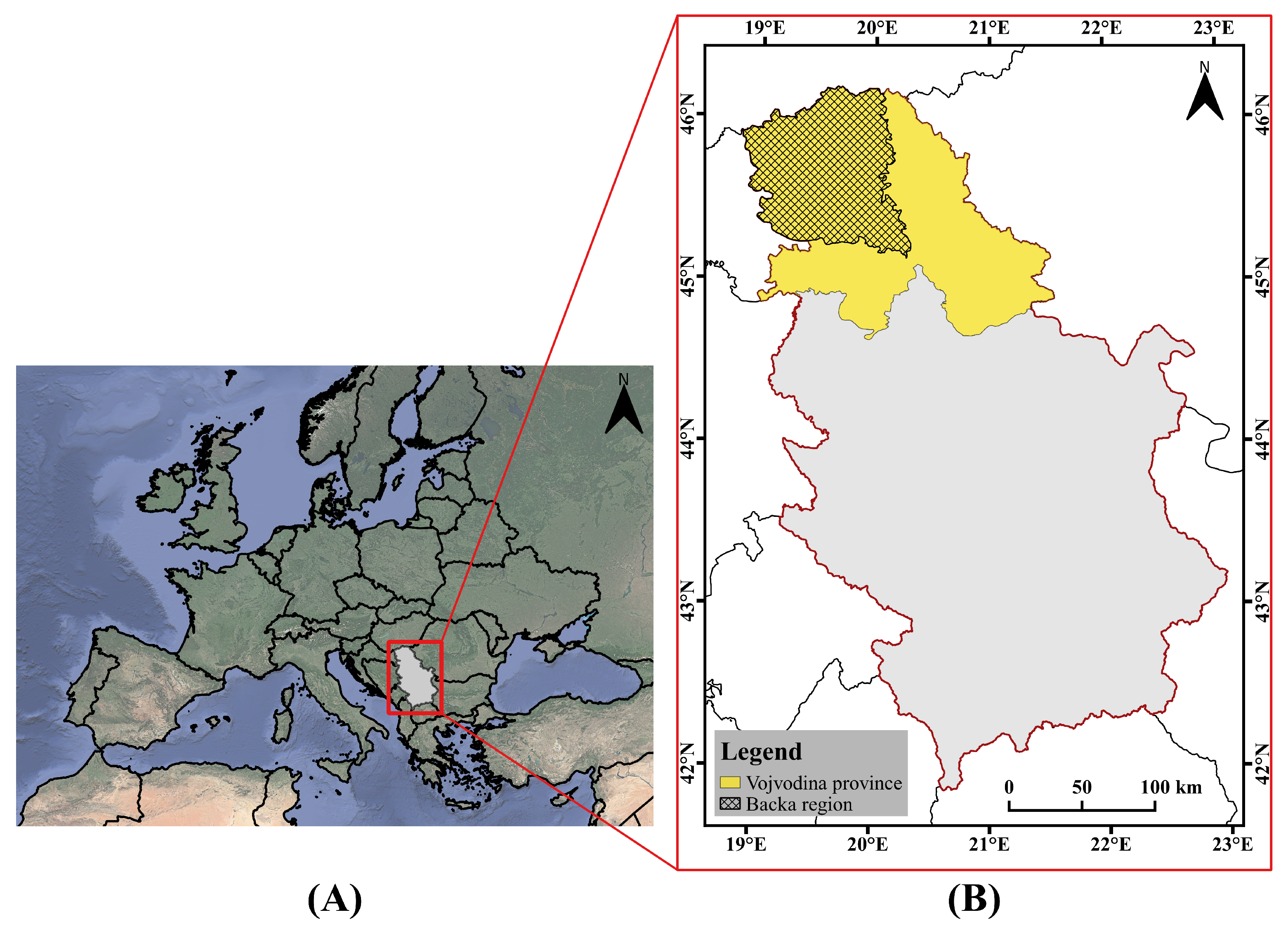
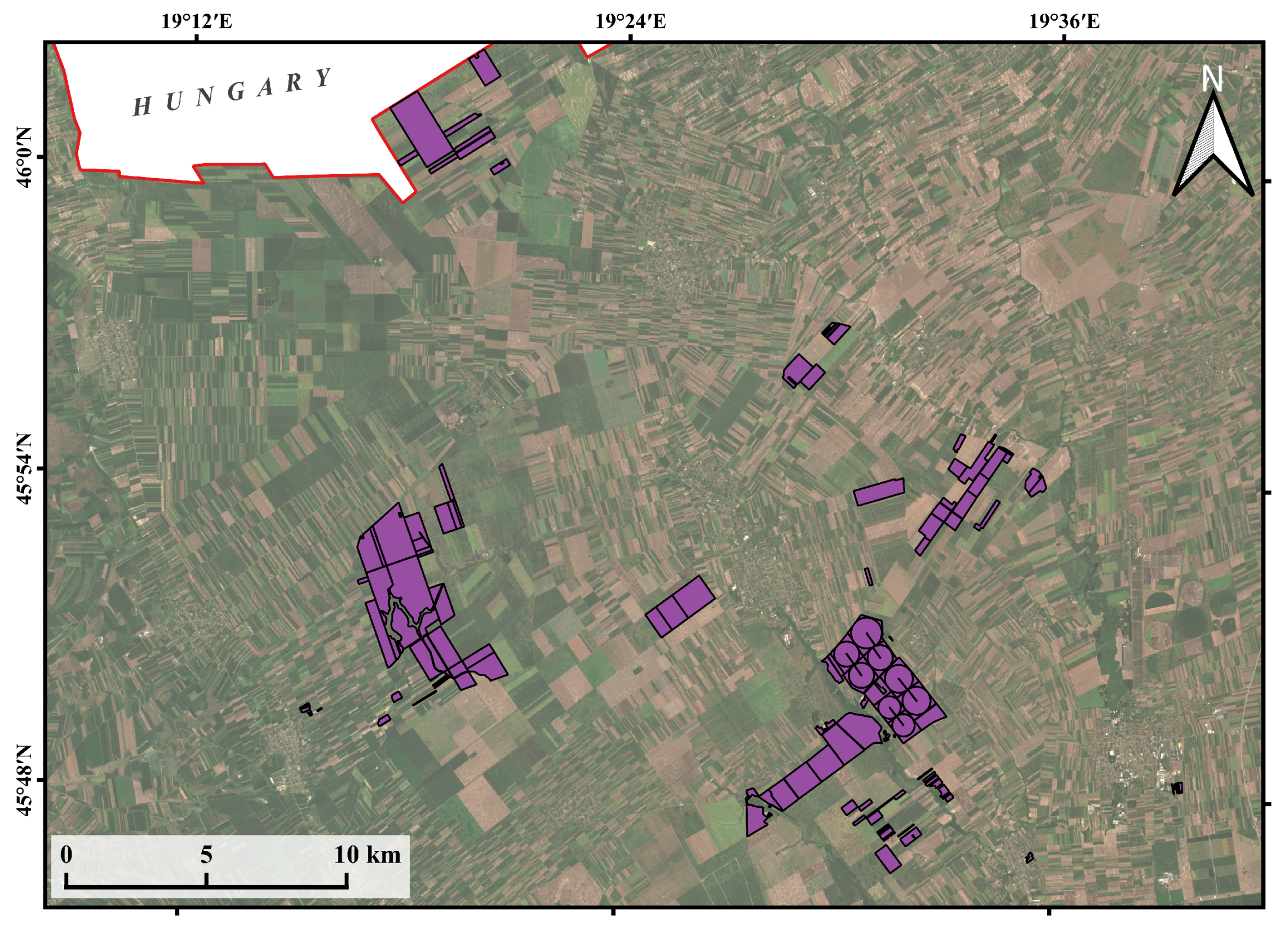
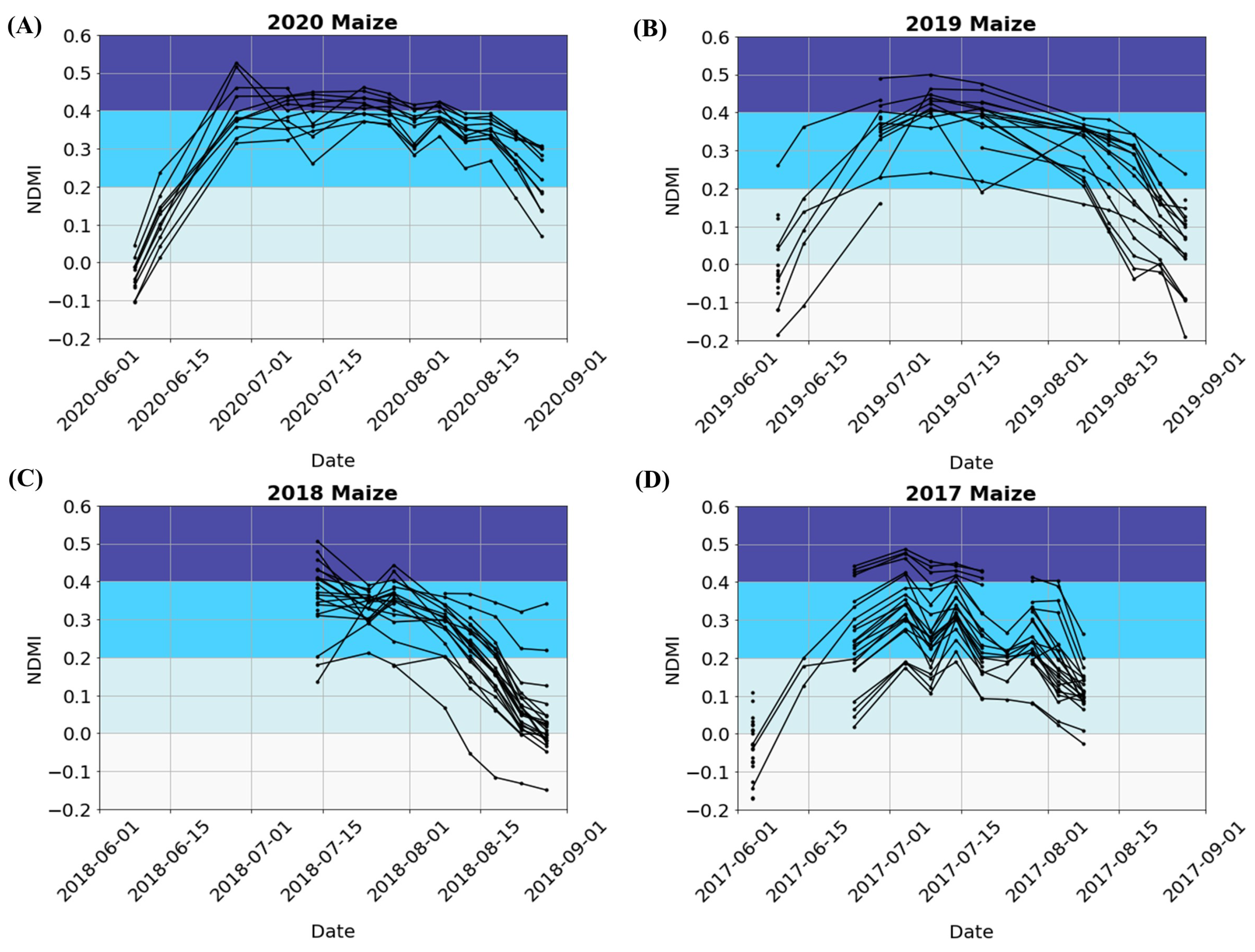
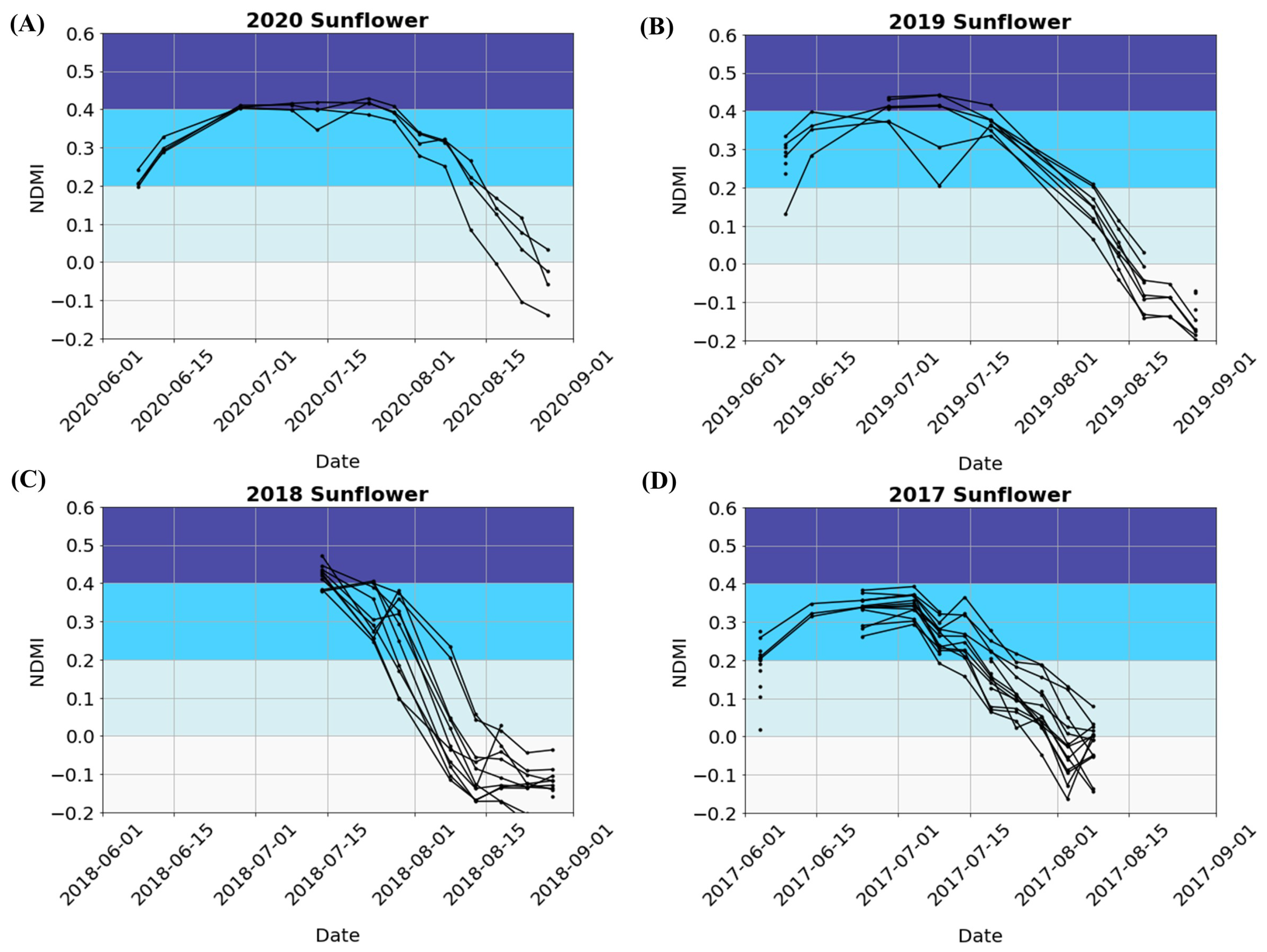
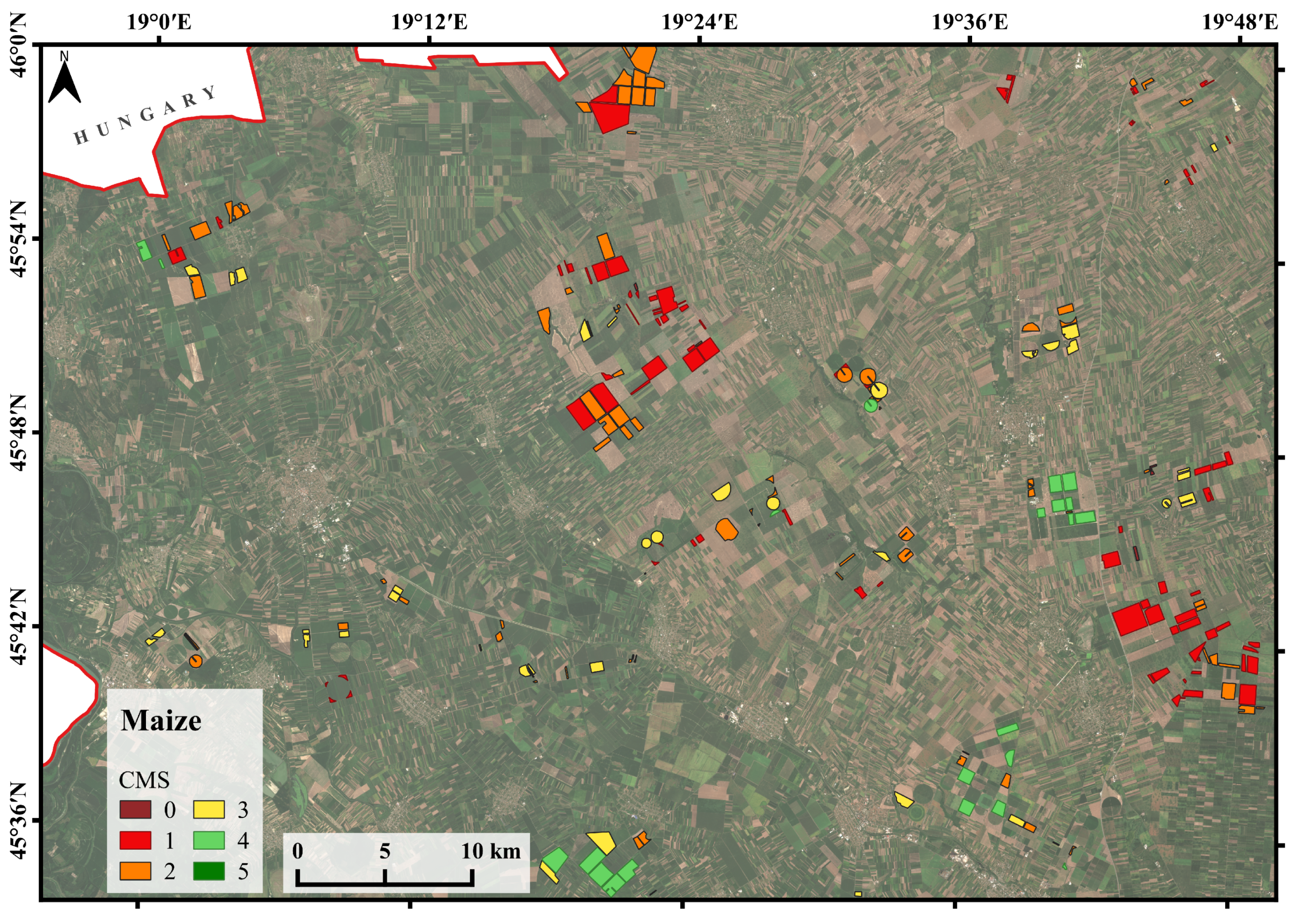
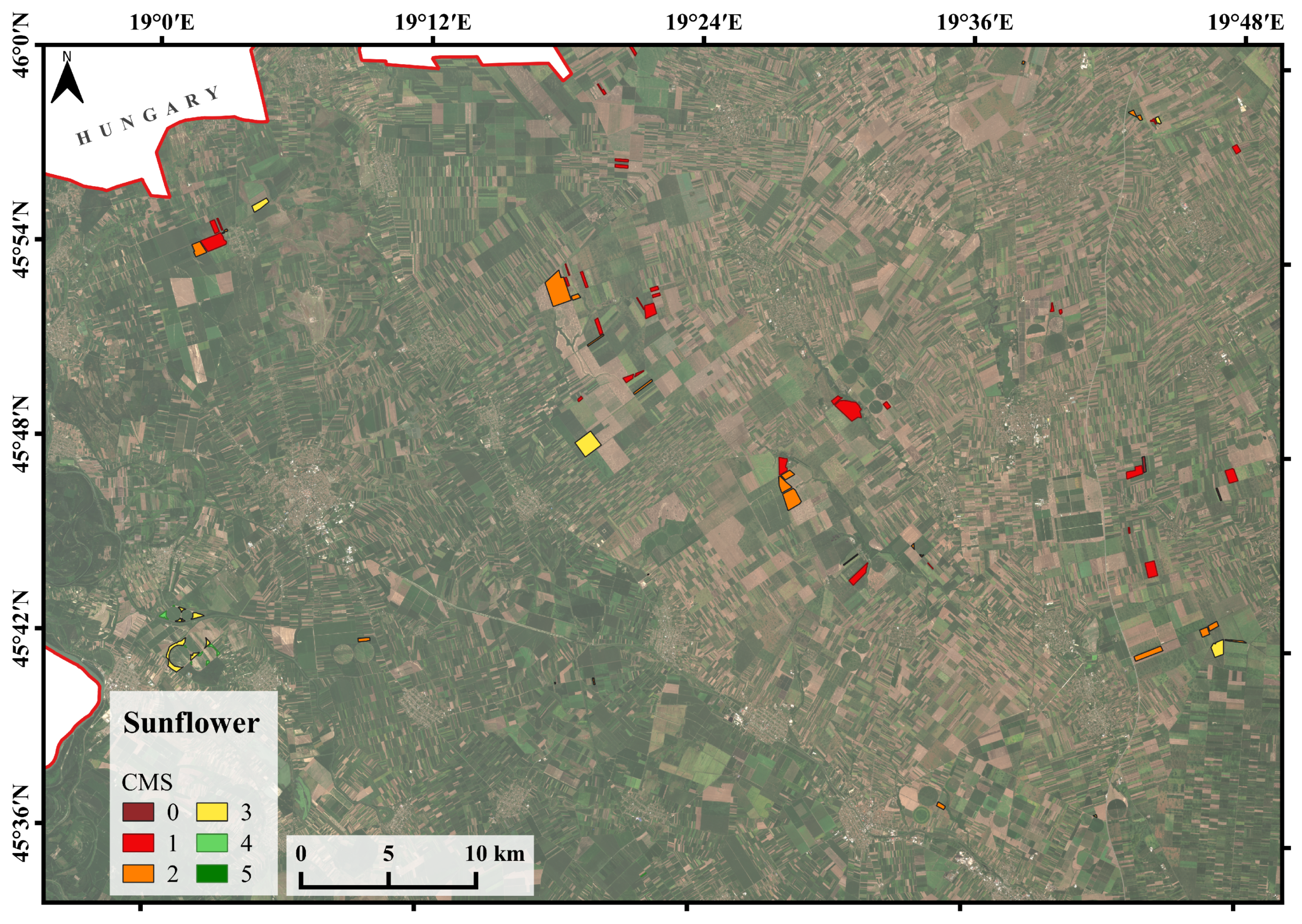
| Moisture Stress | Yield (t/ha) | Std (t/ha) | CMS | Yield (t/ha) | Std (t/ha) |
|---|---|---|---|---|---|
| Dry | - | - | 0 | - | - |
| Low | 4.168 | 4.604 | 1 | - | - |
| Moderate | 9.491 | 3.019 | 2 | 4.168 | 4.604 |
| High | 11.310 | 1.738 | 3 | 7.415 | 2.902 |
| 4 | 10.594 | 2.479 | |||
| 5 | 11.310 | 1.738 |
| Moisture Stress | Yield (t/ha) | Std (t/ha) | CMS | Yield (t/ha) | Std (t/ha) |
|---|---|---|---|---|---|
| Dry | - | - | 0 | - | - |
| Low | 2.510 | 0.501 | 1 | - | - |
| Moderate | 3.440 | 0.841 | 2 | 2.510 | 0.501 |
| High | 3.015 | 0.244 | 3 | 3.167 | 0.802 |
| 4 | 3.621 | 0.842 | |||
| 5 | 3.015 | 0.244 |
| Crop | MBE (t/ha) | MAE (t/ha) | RMSE (t/ha) |
|---|---|---|---|
| Maize | 0.0497 | 0.8498 | 1.0867 |
| Sunflower | −0.1894 | 0.6051 | 0.8288 |
| CMS Class | Field Count | Yield (t/ha) | Std (t/ha) |
|---|---|---|---|
| 0 | 7 | - | - |
| 1 | 94 | - | - |
| 2 | 100 | 1.873 | 0.440 |
| 3 | 100 | 7.154 | 2.784 |
| 4 | 39 | 10.254 | 2.140 |
| 5 | 0 | N/A | N/A |
| CMS Class | Field Count | Yield (t/ha) | Std (t/ha) |
|---|---|---|---|
| 0 | 2 | - | - |
| 1 | 32 | - | - |
| 2 | 22 | 2.421 | 0.469 |
| 3 | 18 | 3.070 | 0.786 |
| 4 | 15 | 3.456 | 0.572 |
| 5 | 0 | N/A | N/A |
Publisher’s Note: MDPI stays neutral with regard to jurisdictional claims in published maps and institutional affiliations. |
© 2022 by the authors. Licensee MDPI, Basel, Switzerland. This article is an open access article distributed under the terms and conditions of the Creative Commons Attribution (CC BY) license (https://creativecommons.org/licenses/by/4.0/).
Share and Cite
Mimić, G.; Živaljević, B.; Blagojević, D.; Pejak, B.; Brdar, S. Quantifying the Effects of Drought Using the Crop Moisture Stress as an Indicator of Maize and Sunflower Yield Reduction in Serbia. Atmosphere 2022, 13, 1880. https://doi.org/10.3390/atmos13111880
Mimić G, Živaljević B, Blagojević D, Pejak B, Brdar S. Quantifying the Effects of Drought Using the Crop Moisture Stress as an Indicator of Maize and Sunflower Yield Reduction in Serbia. Atmosphere. 2022; 13(11):1880. https://doi.org/10.3390/atmos13111880
Chicago/Turabian StyleMimić, Gordan, Branislav Živaljević, Dragana Blagojević, Branislav Pejak, and Sanja Brdar. 2022. "Quantifying the Effects of Drought Using the Crop Moisture Stress as an Indicator of Maize and Sunflower Yield Reduction in Serbia" Atmosphere 13, no. 11: 1880. https://doi.org/10.3390/atmos13111880
APA StyleMimić, G., Živaljević, B., Blagojević, D., Pejak, B., & Brdar, S. (2022). Quantifying the Effects of Drought Using the Crop Moisture Stress as an Indicator of Maize and Sunflower Yield Reduction in Serbia. Atmosphere, 13(11), 1880. https://doi.org/10.3390/atmos13111880







